Analyzing International Trade and Employment: A Regression Report
VerifiedAdded on 2023/04/20
|8
|1657
|329
Report
AI Summary
This report reviews a research paper on the impact of international trade on employment in developing countries, specifically using a quantile regression approach. The review identifies the research question, which explores the effect of international trade on employment rates in developing nations, and the motivation behind it, noting the gap in research focusing on developing countries. The target audience includes low-level firms in developing countries and governments. The report outlines the hypotheses tested, including the relationship between firm-level employment and international trade, and the link between export promotion and employment growth. It details the methodology, including data collection methods and statistical models used, such as the Generalized Method of Moments (GMM) and Quantile Regression (QR). The review also addresses the need for additional tests, like the fixed effects quantile approach, to account for unobserved factors. The findings suggest a statistical difference in employment growth between traders and non-traders, with exports showing a positive relationship and imports a negative one. The report concludes by discussing unresolved issues, such as contradictory results from different approaches, and suggests follow-up research in other sectors using an integration of fixed effect estimation and quantile regression to minimize heterogeneity.
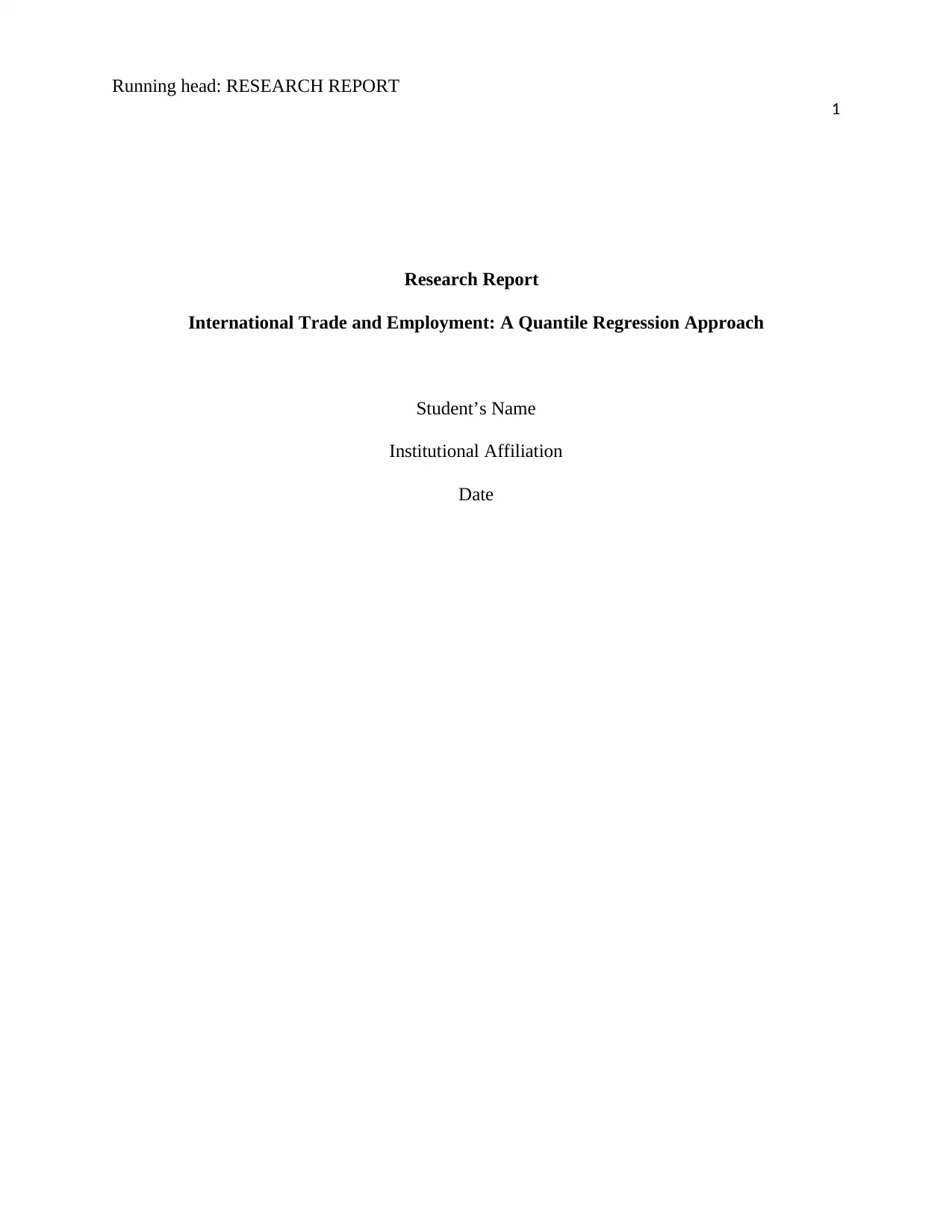
Running head: RESEARCH REPORT
1
Research Report
International Trade and Employment: A Quantile Regression Approach
Student’s Name
Institutional Affiliation
Date
1
Research Report
International Trade and Employment: A Quantile Regression Approach
Student’s Name
Institutional Affiliation
Date
Paraphrase This Document
Need a fresh take? Get an instant paraphrase of this document with our AI Paraphraser
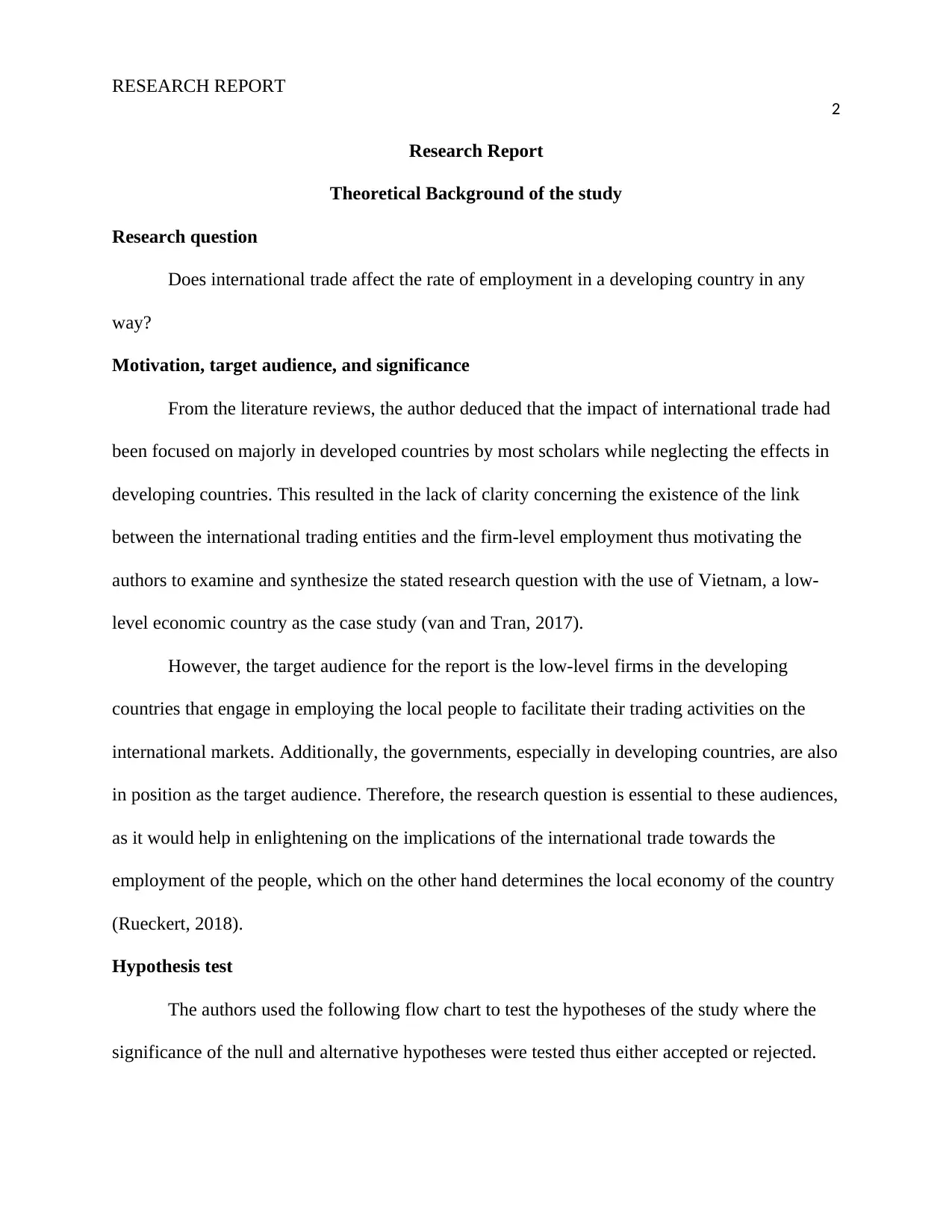
RESEARCH REPORT
2
Research Report
Theoretical Background of the study
Research question
Does international trade affect the rate of employment in a developing country in any
way?
Motivation, target audience, and significance
From the literature reviews, the author deduced that the impact of international trade had
been focused on majorly in developed countries by most scholars while neglecting the effects in
developing countries. This resulted in the lack of clarity concerning the existence of the link
between the international trading entities and the firm-level employment thus motivating the
authors to examine and synthesize the stated research question with the use of Vietnam, a low-
level economic country as the case study (van and Tran, 2017).
However, the target audience for the report is the low-level firms in the developing
countries that engage in employing the local people to facilitate their trading activities on the
international markets. Additionally, the governments, especially in developing countries, are also
in position as the target audience. Therefore, the research question is essential to these audiences,
as it would help in enlightening on the implications of the international trade towards the
employment of the people, which on the other hand determines the local economy of the country
(Rueckert, 2018).
Hypothesis test
The authors used the following flow chart to test the hypotheses of the study where the
significance of the null and alternative hypotheses were tested thus either accepted or rejected.
2
Research Report
Theoretical Background of the study
Research question
Does international trade affect the rate of employment in a developing country in any
way?
Motivation, target audience, and significance
From the literature reviews, the author deduced that the impact of international trade had
been focused on majorly in developed countries by most scholars while neglecting the effects in
developing countries. This resulted in the lack of clarity concerning the existence of the link
between the international trading entities and the firm-level employment thus motivating the
authors to examine and synthesize the stated research question with the use of Vietnam, a low-
level economic country as the case study (van and Tran, 2017).
However, the target audience for the report is the low-level firms in the developing
countries that engage in employing the local people to facilitate their trading activities on the
international markets. Additionally, the governments, especially in developing countries, are also
in position as the target audience. Therefore, the research question is essential to these audiences,
as it would help in enlightening on the implications of the international trade towards the
employment of the people, which on the other hand determines the local economy of the country
(Rueckert, 2018).
Hypothesis test
The authors used the following flow chart to test the hypotheses of the study where the
significance of the null and alternative hypotheses were tested thus either accepted or rejected.
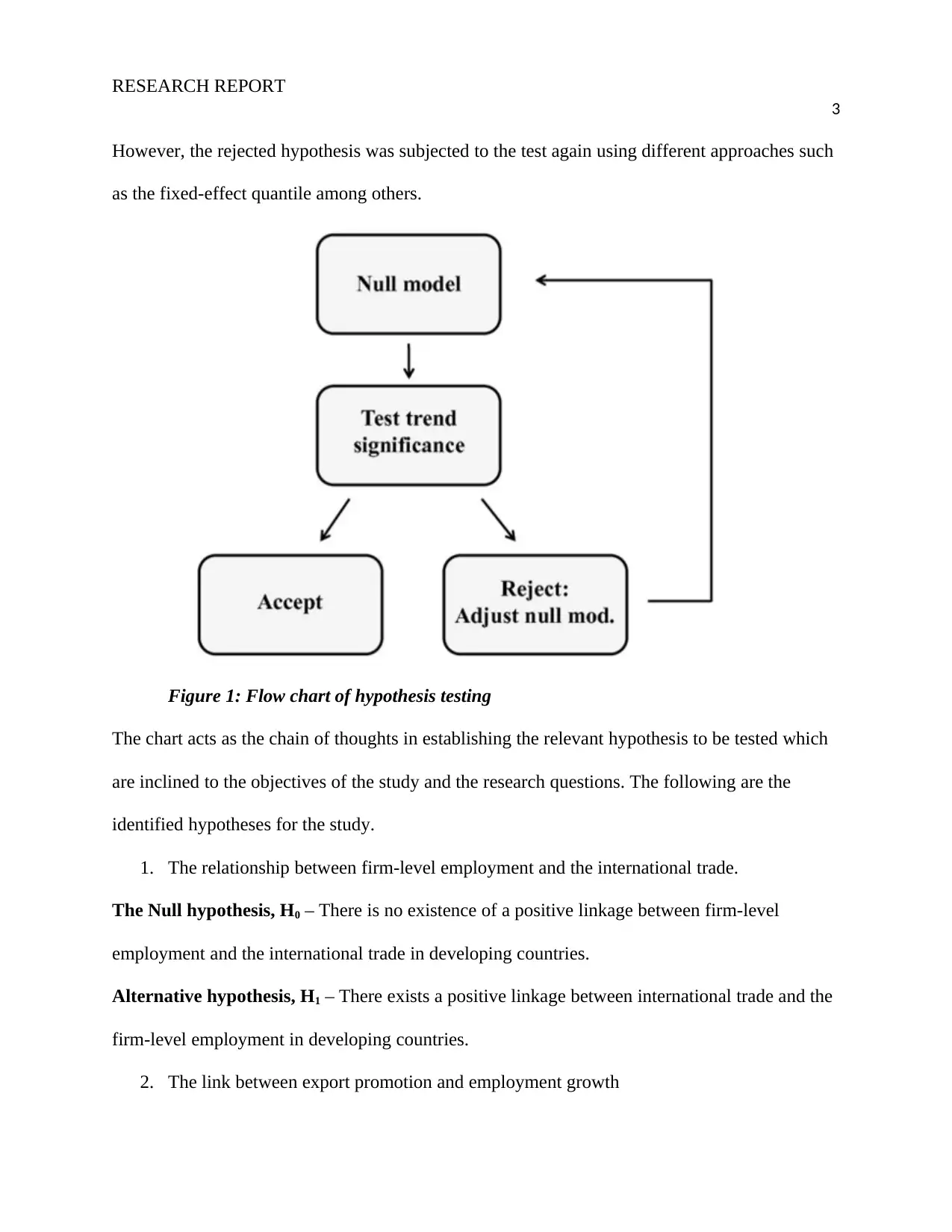
RESEARCH REPORT
3
However, the rejected hypothesis was subjected to the test again using different approaches such
as the fixed-effect quantile among others.
Figure 1: Flow chart of hypothesis testing
The chart acts as the chain of thoughts in establishing the relevant hypothesis to be tested which
are inclined to the objectives of the study and the research questions. The following are the
identified hypotheses for the study.
1. The relationship between firm-level employment and the international trade.
The Null hypothesis, H0 – There is no existence of a positive linkage between firm-level
employment and the international trade in developing countries.
Alternative hypothesis, H1 – There exists a positive linkage between international trade and the
firm-level employment in developing countries.
2. The link between export promotion and employment growth
3
However, the rejected hypothesis was subjected to the test again using different approaches such
as the fixed-effect quantile among others.
Figure 1: Flow chart of hypothesis testing
The chart acts as the chain of thoughts in establishing the relevant hypothesis to be tested which
are inclined to the objectives of the study and the research questions. The following are the
identified hypotheses for the study.
1. The relationship between firm-level employment and the international trade.
The Null hypothesis, H0 – There is no existence of a positive linkage between firm-level
employment and the international trade in developing countries.
Alternative hypothesis, H1 – There exists a positive linkage between international trade and the
firm-level employment in developing countries.
2. The link between export promotion and employment growth
⊘ This is a preview!⊘
Do you want full access?
Subscribe today to unlock all pages.

Trusted by 1+ million students worldwide
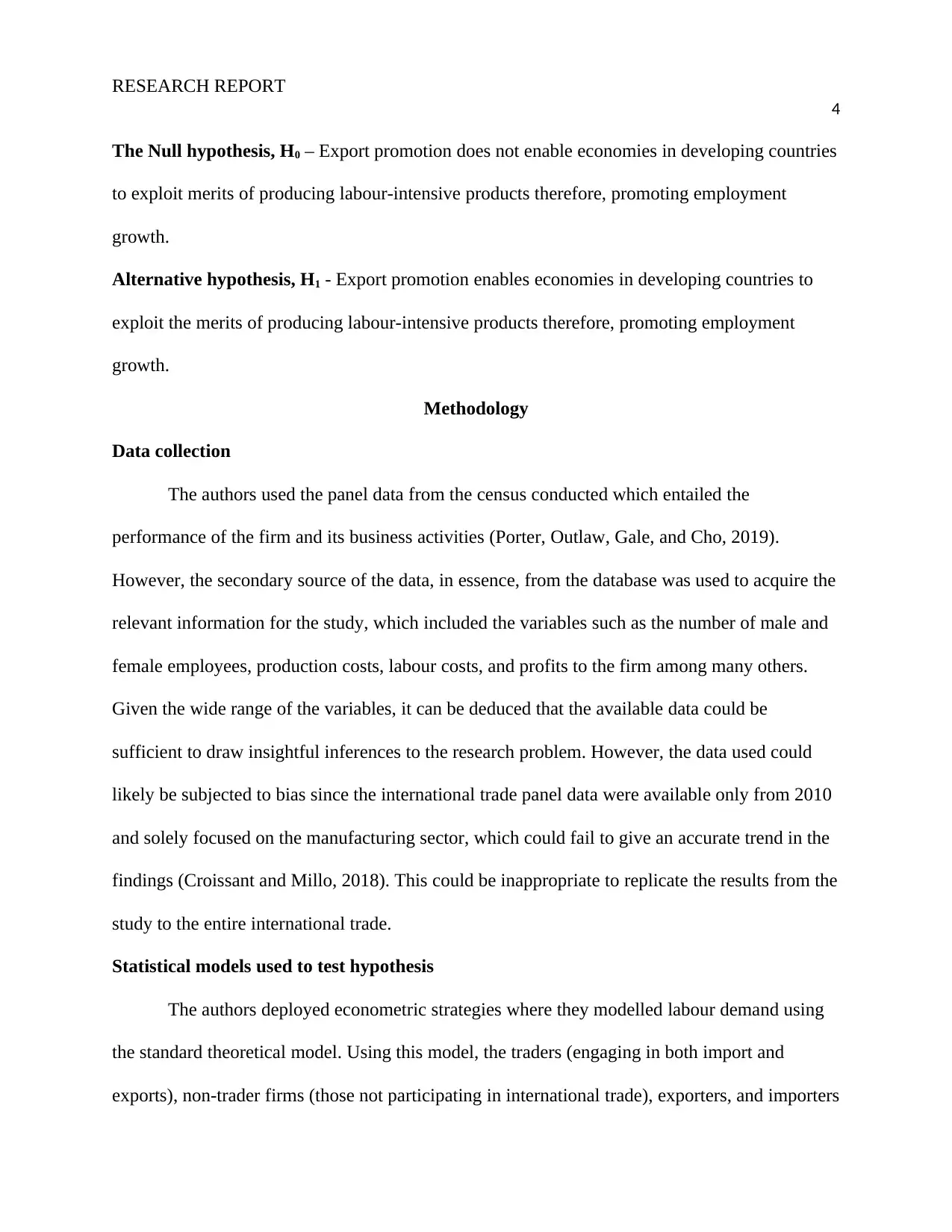
RESEARCH REPORT
4
The Null hypothesis, H0 – Export promotion does not enable economies in developing countries
to exploit merits of producing labour-intensive products therefore, promoting employment
growth.
Alternative hypothesis, H1 - Export promotion enables economies in developing countries to
exploit the merits of producing labour-intensive products therefore, promoting employment
growth.
Methodology
Data collection
The authors used the panel data from the census conducted which entailed the
performance of the firm and its business activities (Porter, Outlaw, Gale, and Cho, 2019).
However, the secondary source of the data, in essence, from the database was used to acquire the
relevant information for the study, which included the variables such as the number of male and
female employees, production costs, labour costs, and profits to the firm among many others.
Given the wide range of the variables, it can be deduced that the available data could be
sufficient to draw insightful inferences to the research problem. However, the data used could
likely be subjected to bias since the international trade panel data were available only from 2010
and solely focused on the manufacturing sector, which could fail to give an accurate trend in the
findings (Croissant and Millo, 2018). This could be inappropriate to replicate the results from the
study to the entire international trade.
Statistical models used to test hypothesis
The authors deployed econometric strategies where they modelled labour demand using
the standard theoretical model. Using this model, the traders (engaging in both import and
exports), non-trader firms (those not participating in international trade), exporters, and importers
4
The Null hypothesis, H0 – Export promotion does not enable economies in developing countries
to exploit merits of producing labour-intensive products therefore, promoting employment
growth.
Alternative hypothesis, H1 - Export promotion enables economies in developing countries to
exploit the merits of producing labour-intensive products therefore, promoting employment
growth.
Methodology
Data collection
The authors used the panel data from the census conducted which entailed the
performance of the firm and its business activities (Porter, Outlaw, Gale, and Cho, 2019).
However, the secondary source of the data, in essence, from the database was used to acquire the
relevant information for the study, which included the variables such as the number of male and
female employees, production costs, labour costs, and profits to the firm among many others.
Given the wide range of the variables, it can be deduced that the available data could be
sufficient to draw insightful inferences to the research problem. However, the data used could
likely be subjected to bias since the international trade panel data were available only from 2010
and solely focused on the manufacturing sector, which could fail to give an accurate trend in the
findings (Croissant and Millo, 2018). This could be inappropriate to replicate the results from the
study to the entire international trade.
Statistical models used to test hypothesis
The authors deployed econometric strategies where they modelled labour demand using
the standard theoretical model. Using this model, the traders (engaging in both import and
exports), non-trader firms (those not participating in international trade), exporters, and importers
Paraphrase This Document
Need a fresh take? Get an instant paraphrase of this document with our AI Paraphraser
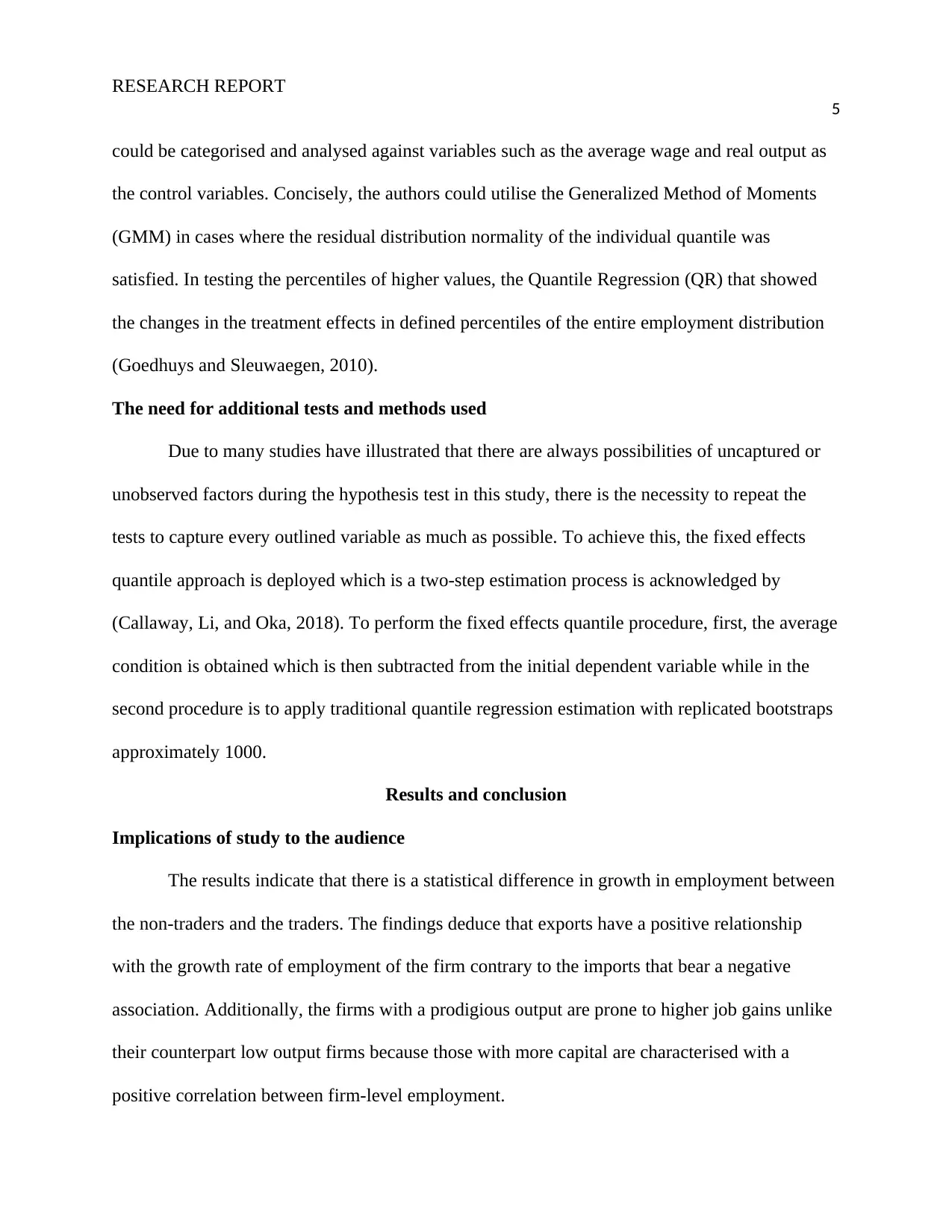
RESEARCH REPORT
5
could be categorised and analysed against variables such as the average wage and real output as
the control variables. Concisely, the authors could utilise the Generalized Method of Moments
(GMM) in cases where the residual distribution normality of the individual quantile was
satisfied. In testing the percentiles of higher values, the Quantile Regression (QR) that showed
the changes in the treatment effects in defined percentiles of the entire employment distribution
(Goedhuys and Sleuwaegen, 2010).
The need for additional tests and methods used
Due to many studies have illustrated that there are always possibilities of uncaptured or
unobserved factors during the hypothesis test in this study, there is the necessity to repeat the
tests to capture every outlined variable as much as possible. To achieve this, the fixed effects
quantile approach is deployed which is a two-step estimation process is acknowledged by
(Callaway, Li, and Oka, 2018). To perform the fixed effects quantile procedure, first, the average
condition is obtained which is then subtracted from the initial dependent variable while in the
second procedure is to apply traditional quantile regression estimation with replicated bootstraps
approximately 1000.
Results and conclusion
Implications of study to the audience
The results indicate that there is a statistical difference in growth in employment between
the non-traders and the traders. The findings deduce that exports have a positive relationship
with the growth rate of employment of the firm contrary to the imports that bear a negative
association. Additionally, the firms with a prodigious output are prone to higher job gains unlike
their counterpart low output firms because those with more capital are characterised with a
positive correlation between firm-level employment.
5
could be categorised and analysed against variables such as the average wage and real output as
the control variables. Concisely, the authors could utilise the Generalized Method of Moments
(GMM) in cases where the residual distribution normality of the individual quantile was
satisfied. In testing the percentiles of higher values, the Quantile Regression (QR) that showed
the changes in the treatment effects in defined percentiles of the entire employment distribution
(Goedhuys and Sleuwaegen, 2010).
The need for additional tests and methods used
Due to many studies have illustrated that there are always possibilities of uncaptured or
unobserved factors during the hypothesis test in this study, there is the necessity to repeat the
tests to capture every outlined variable as much as possible. To achieve this, the fixed effects
quantile approach is deployed which is a two-step estimation process is acknowledged by
(Callaway, Li, and Oka, 2018). To perform the fixed effects quantile procedure, first, the average
condition is obtained which is then subtracted from the initial dependent variable while in the
second procedure is to apply traditional quantile regression estimation with replicated bootstraps
approximately 1000.
Results and conclusion
Implications of study to the audience
The results indicate that there is a statistical difference in growth in employment between
the non-traders and the traders. The findings deduce that exports have a positive relationship
with the growth rate of employment of the firm contrary to the imports that bear a negative
association. Additionally, the firms with a prodigious output are prone to higher job gains unlike
their counterpart low output firms because those with more capital are characterised with a
positive correlation between firm-level employment.
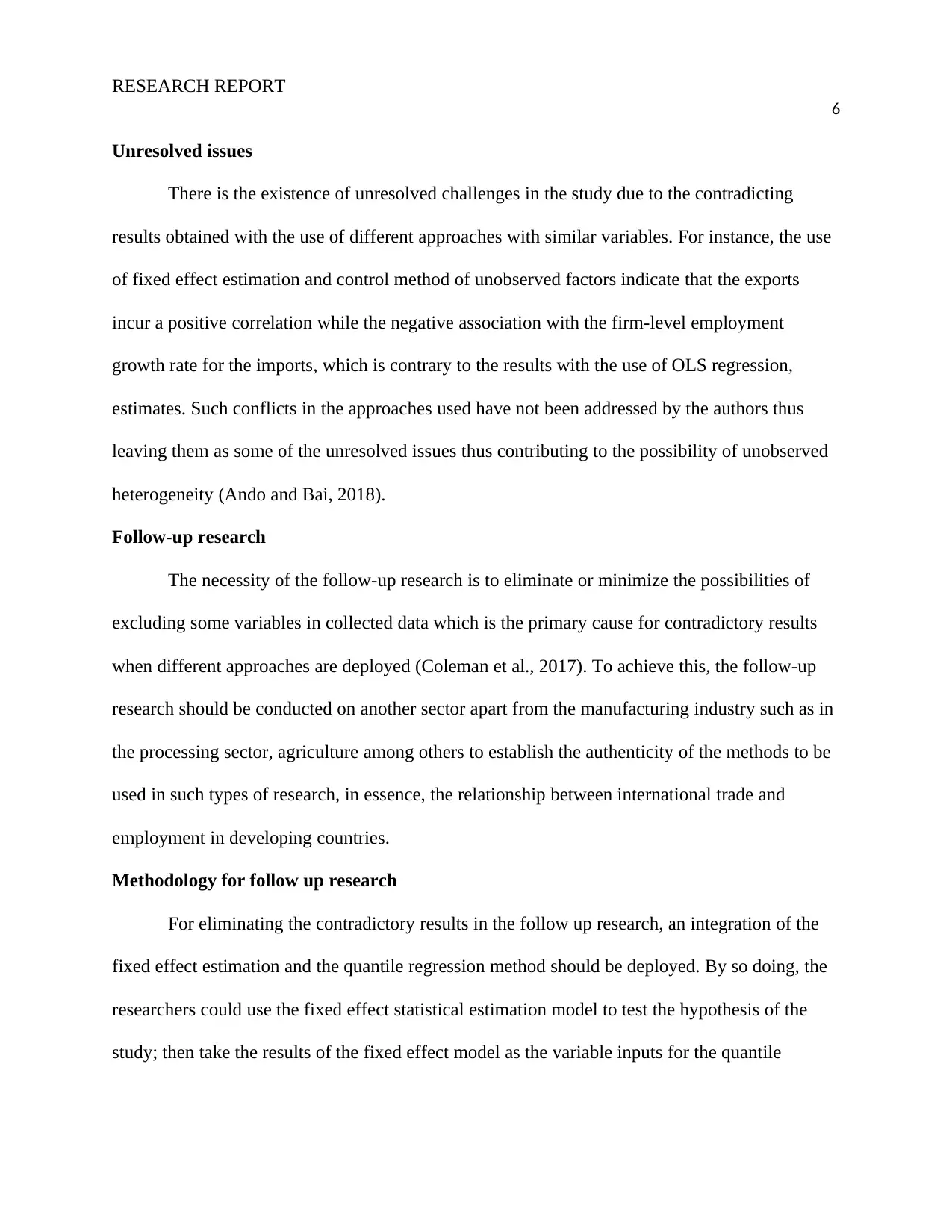
RESEARCH REPORT
6
Unresolved issues
There is the existence of unresolved challenges in the study due to the contradicting
results obtained with the use of different approaches with similar variables. For instance, the use
of fixed effect estimation and control method of unobserved factors indicate that the exports
incur a positive correlation while the negative association with the firm-level employment
growth rate for the imports, which is contrary to the results with the use of OLS regression,
estimates. Such conflicts in the approaches used have not been addressed by the authors thus
leaving them as some of the unresolved issues thus contributing to the possibility of unobserved
heterogeneity (Ando and Bai, 2018).
Follow-up research
The necessity of the follow-up research is to eliminate or minimize the possibilities of
excluding some variables in collected data which is the primary cause for contradictory results
when different approaches are deployed (Coleman et al., 2017). To achieve this, the follow-up
research should be conducted on another sector apart from the manufacturing industry such as in
the processing sector, agriculture among others to establish the authenticity of the methods to be
used in such types of research, in essence, the relationship between international trade and
employment in developing countries.
Methodology for follow up research
For eliminating the contradictory results in the follow up research, an integration of the
fixed effect estimation and the quantile regression method should be deployed. By so doing, the
researchers could use the fixed effect statistical estimation model to test the hypothesis of the
study; then take the results of the fixed effect model as the variable inputs for the quantile
6
Unresolved issues
There is the existence of unresolved challenges in the study due to the contradicting
results obtained with the use of different approaches with similar variables. For instance, the use
of fixed effect estimation and control method of unobserved factors indicate that the exports
incur a positive correlation while the negative association with the firm-level employment
growth rate for the imports, which is contrary to the results with the use of OLS regression,
estimates. Such conflicts in the approaches used have not been addressed by the authors thus
leaving them as some of the unresolved issues thus contributing to the possibility of unobserved
heterogeneity (Ando and Bai, 2018).
Follow-up research
The necessity of the follow-up research is to eliminate or minimize the possibilities of
excluding some variables in collected data which is the primary cause for contradictory results
when different approaches are deployed (Coleman et al., 2017). To achieve this, the follow-up
research should be conducted on another sector apart from the manufacturing industry such as in
the processing sector, agriculture among others to establish the authenticity of the methods to be
used in such types of research, in essence, the relationship between international trade and
employment in developing countries.
Methodology for follow up research
For eliminating the contradictory results in the follow up research, an integration of the
fixed effect estimation and the quantile regression method should be deployed. By so doing, the
researchers could use the fixed effect statistical estimation model to test the hypothesis of the
study; then take the results of the fixed effect model as the variable inputs for the quantile
⊘ This is a preview!⊘
Do you want full access?
Subscribe today to unlock all pages.

Trusted by 1+ million students worldwide
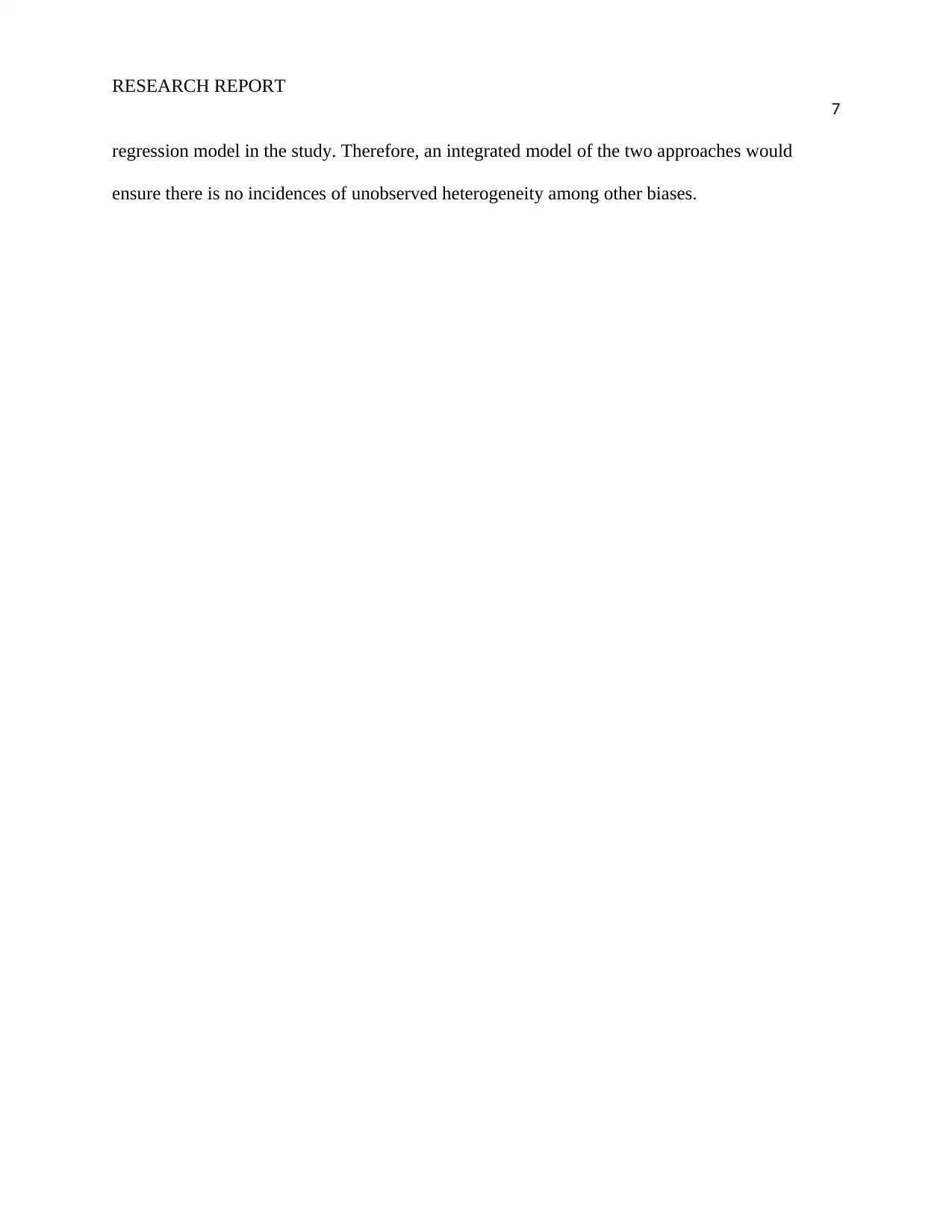
RESEARCH REPORT
7
regression model in the study. Therefore, an integrated model of the two approaches would
ensure there is no incidences of unobserved heterogeneity among other biases.
7
regression model in the study. Therefore, an integrated model of the two approaches would
ensure there is no incidences of unobserved heterogeneity among other biases.
Paraphrase This Document
Need a fresh take? Get an instant paraphrase of this document with our AI Paraphraser
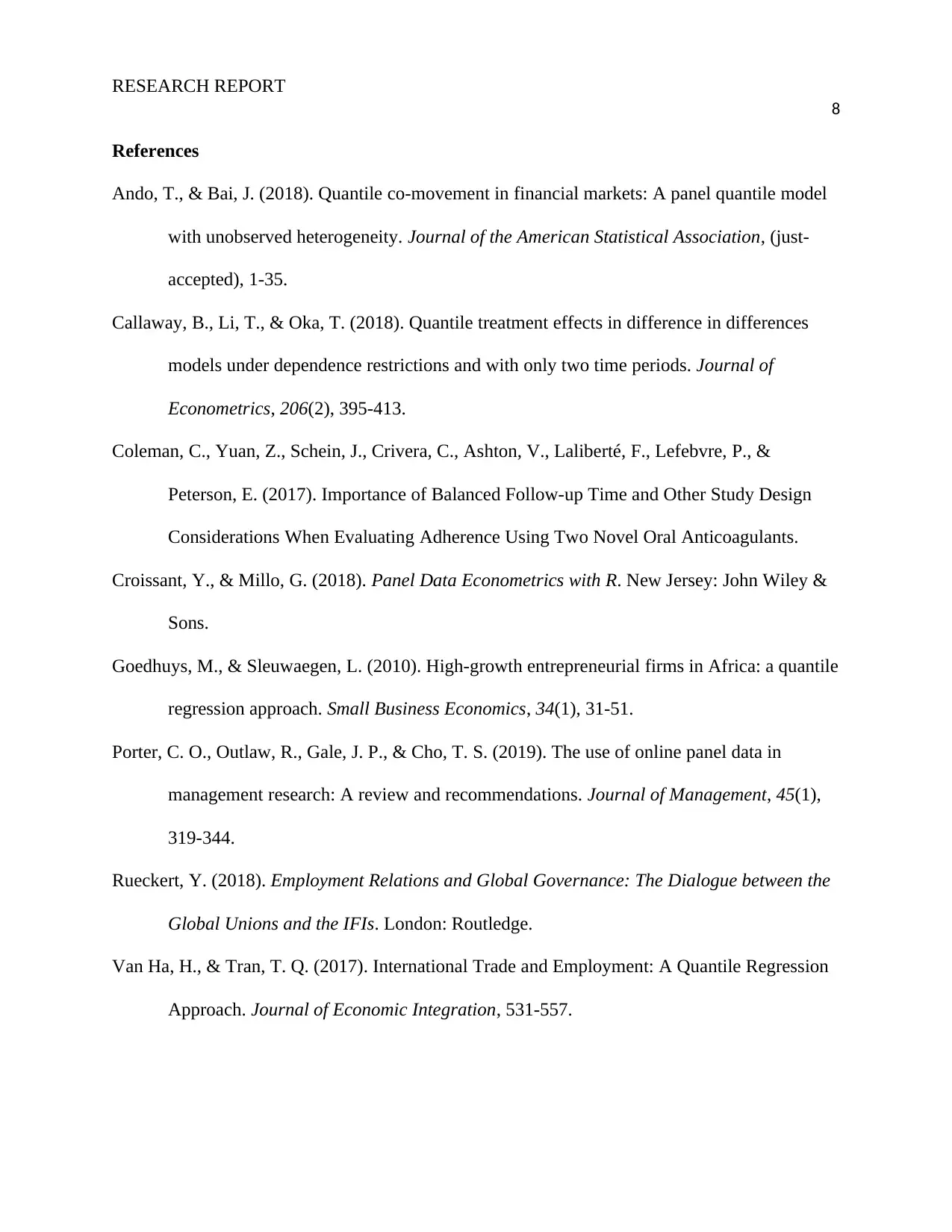
RESEARCH REPORT
8
References
Ando, T., & Bai, J. (2018). Quantile co-movement in financial markets: A panel quantile model
with unobserved heterogeneity. Journal of the American Statistical Association, (just-
accepted), 1-35.
Callaway, B., Li, T., & Oka, T. (2018). Quantile treatment effects in difference in differences
models under dependence restrictions and with only two time periods. Journal of
Econometrics, 206(2), 395-413.
Coleman, C., Yuan, Z., Schein, J., Crivera, C., Ashton, V., Laliberté, F., Lefebvre, P., &
Peterson, E. (2017). Importance of Balanced Follow-up Time and Other Study Design
Considerations When Evaluating Adherence Using Two Novel Oral Anticoagulants.
Croissant, Y., & Millo, G. (2018). Panel Data Econometrics with R. New Jersey: John Wiley &
Sons.
Goedhuys, M., & Sleuwaegen, L. (2010). High-growth entrepreneurial firms in Africa: a quantile
regression approach. Small Business Economics, 34(1), 31-51.
Porter, C. O., Outlaw, R., Gale, J. P., & Cho, T. S. (2019). The use of online panel data in
management research: A review and recommendations. Journal of Management, 45(1),
319-344.
Rueckert, Y. (2018). Employment Relations and Global Governance: The Dialogue between the
Global Unions and the IFIs. London: Routledge.
Van Ha, H., & Tran, T. Q. (2017). International Trade and Employment: A Quantile Regression
Approach. Journal of Economic Integration, 531-557.
8
References
Ando, T., & Bai, J. (2018). Quantile co-movement in financial markets: A panel quantile model
with unobserved heterogeneity. Journal of the American Statistical Association, (just-
accepted), 1-35.
Callaway, B., Li, T., & Oka, T. (2018). Quantile treatment effects in difference in differences
models under dependence restrictions and with only two time periods. Journal of
Econometrics, 206(2), 395-413.
Coleman, C., Yuan, Z., Schein, J., Crivera, C., Ashton, V., Laliberté, F., Lefebvre, P., &
Peterson, E. (2017). Importance of Balanced Follow-up Time and Other Study Design
Considerations When Evaluating Adherence Using Two Novel Oral Anticoagulants.
Croissant, Y., & Millo, G. (2018). Panel Data Econometrics with R. New Jersey: John Wiley &
Sons.
Goedhuys, M., & Sleuwaegen, L. (2010). High-growth entrepreneurial firms in Africa: a quantile
regression approach. Small Business Economics, 34(1), 31-51.
Porter, C. O., Outlaw, R., Gale, J. P., & Cho, T. S. (2019). The use of online panel data in
management research: A review and recommendations. Journal of Management, 45(1),
319-344.
Rueckert, Y. (2018). Employment Relations and Global Governance: The Dialogue between the
Global Unions and the IFIs. London: Routledge.
Van Ha, H., & Tran, T. Q. (2017). International Trade and Employment: A Quantile Regression
Approach. Journal of Economic Integration, 531-557.
1 out of 8
Related Documents
Your All-in-One AI-Powered Toolkit for Academic Success.
+13062052269
info@desklib.com
Available 24*7 on WhatsApp / Email
![[object Object]](/_next/static/media/star-bottom.7253800d.svg)
Unlock your academic potential
Copyright © 2020–2025 A2Z Services. All Rights Reserved. Developed and managed by ZUCOL.





